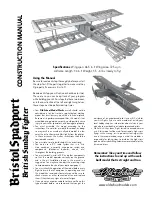
Construction Manual
www.oldschoolmodels.com
Page 7
British
Sunday Fighter
Bristol Spadport
Step 26 - Top Wing Assembly (tab removal)
Now it’s time to remove the tabs from the bottom of the trailing
edge. These should be carefully cut away, then sanded so they
allow the continuation of the airfoil’s shape.
Because R1 is made from ply, we found it easiest to first use a pair
of side-cutters or a saw to remove the majority of the tab, then
sand.
Step 27 - Top Wing Assembly (lower, rear sheeting)
Locate another of the pre-cut strips
of wing sheeting from BP10. This
strip is glued in place as shown,
along the rear of the ribs and butting
up against the trailing edge strip.
Again, using a long straight-edge
can help hold down this strip while
gluing.
Step 28 - Top Wing Assembly (lower sub-spar)
Next, locate another of the 1/8” square
balsa strips. Measure and cut to length,
leaving about 1/5” extra on each end.
Glue this in place, making sure it is
securely glued into the pre-cut slots of
each rib.
Note that this piece will “dip” when
gluing to the pre-cut slots in R5, R3 and
R1. This is to allow for the wing’s center
sheeting. So make sure this strip is fully
inserted into the slots of each and every rib.
Step 29 - Top Wing Assembly (rear center section)
Using more of the 1/16” balsa
sheeting, now you will measure, cut
and glue in the lower, center sheeting
as shown here.
Use the same techniques as you did
when installing the upper sheeting
back in step 18. The only difference
here is that you’ll also have to mark
and cut two small openings where the steel straps will protrude.
Step 30 - Top Wing Assembly (CM1 assembly)
Locate two CM1’s from LP1, two of the 1/8” dowels you
cut earlier and one steel strap.
Push the two dowels halfway into the
holes in CM1. Now note the curvature of
CM1 as the more “curved” surface will be
oriented downward.
Carefully push the two dowels in the CM1
assembly into the pre-cut holes towards
the front of R11. Make sure this is on the proper
side of the rib (the side facing the root rib). Glue
this to R11. Then glue the other CM1 in place on
the other side of the rib. Drill out the holes in the
steel strap as you did previously and glue the strap in place.
Step 31 - Top Wing Assembly (CM2 assembly)
Locate one CM2 from LP1, two of the 1/8” dowels you cut earlier
and one steel strap.
Push the two dowels halfway into the holes in CM2.
Now note the curvature of CM2 as the more “curved”
surface will be oriented downward.
Carefully push the two dowels in the CM2
assembly into the pre-cut holes towards the rear
of R11. Make sure this is on the proper side of
the rib (the side facing the tip rib). Glue this to R11.
Then drill out the holes in the steel strap as you did previously and
glue the strap in place.
Step 32 - Top Wing Assembly (TR and TIP)
Before this step, take a minute
to sand any of the spars,
leading and/or trailing edge
wood that extend past R9, as
you’ll need a flat face for this
step.
Locate two TR from BP1 and
one TIP from LP5. The two TR
pieces are glued, one on top of the other.
Then glue the TR assembly to the flat surface of R9 on the outer tip
of the wing, making sure it is properly aligned with R9.
Then glue TIP in place as shown, making sure it is level with the
wing.
Step 33 - Top Wing Assembly (R1 cutout)
The last step in this half of the top wing is to mark
and cutout a slot in R1. This will be a rectangle and
is positioned between the upper and lower spars,
as well as the front and rear sheer webs. Refer to
this drawing as a guide.
Use a rotary tool for the main portion, then a
sharp hobby knife for the corners. Take care not to
damage the balsa sheer webs or weaken the spars.
Set the top port wing half aside and begin work on the top
starboard (right) wing half. Tape the right wing plan and fresh wax
paper on your board. Then follow steps 1 through 33 to complete
the starboard wing half. Once finished, then move on to step 34.
Note that when building the starboard half that many of the
parts will need to be glued to the opposite side (the sheer
webs, for instance). Always refer to the plans to make sure
you’re gluing the parts together in the correct way.
This completes the sub assemblies of the top wing.
Now you’ll assemble the bottom wing halves.
Step 34 - Bottom Wing Assembly
The bottom wings are largely constructed in the same way as
the top wings. The rib numbers are different, but the general
construction is the same. Build both wing halves using the same
techniques as you did on the top wing, steps 1-16, then come back
to step 35 for the steps unique to the bottom wing halves.
Start with the lower spar, then add the ribs and sheer webs from
the tip, into the root. Add the lite ply R10B to the inner surface of
R10.
Trailing and leading edge is next, followed by the upper-sub spar.
Cut out this
area from R1








































